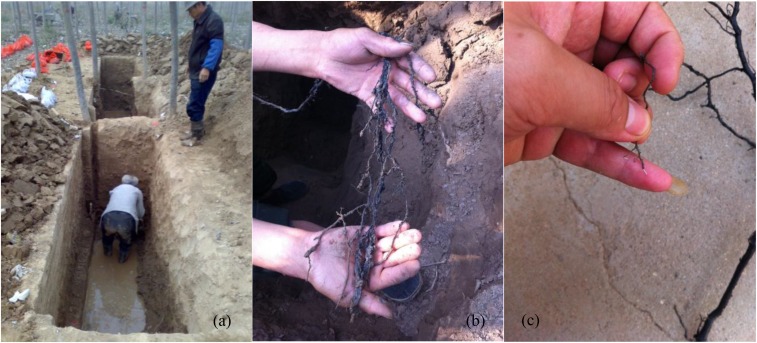In PNAS, Fan et al. (1) demonstrate that water table depth (WTD) is a vital determinant and a good predictor of plant rooting depth at a global scale. However, Pierret and Lacombe (2) point out that there are some plants extending their roots far below the WTD [figure 3F and figure S6 in Fan et al. (1)]. In their reply to those authors, Fan et al. (3) propose that some of these exceptions are possibly due to a temporarily shallow water table. However, this phenomenon can be more plausibly explained by groundwater table fluctuation (GTF). Seasonal GTF caused by precipitation recharge, overexploitation, and global climate change is widespread in seasonal drought regions of the world (4–6). Nevertheless, root system studies under seasonal GTF are rarely reported (7) and also are not discussed by Fan et al. (1).
Our work, conducted in a Populus tomentosa plantation on the North China Plain (7), found that maximum rooting depth can reach 270-cm under long-term intensive seasonal GTF, ranging from 48 to 411 cm WTD (data averaged over 4 y). To adapt to these kinds of growing conditions, P. tomentosa develops a deep root system, with densely wide-spreading lateral roots and some structural roots with the ability to explore both shallow and deep soil water resources. This indicates that intensive GTF will not negatively affect—but rather facilitate—the formation of a deep root system in ecosystems experiencing seasonal drought. Live roots of P. tomentosa penetrating below WTD are shown in Fig. 1. In addition to the adaptations that are mentioned by Pierret and Lacombe (2), maintaining part of the root system below the water table through the death of the thinnest roots, and the formation of new fine roots in the surface soil, can be other waterlogging adaptation strategies of plants (7, 8).
Fig. 1.
Live roots of P. tomentosa growing below the WTD in the North China Plain. (A) Root sampling down to the WTD in 2009. (B and C) Live roots at depth of 270 cm, which were sampled after the WTD dropped in the spring of 2012.
Fan et al. (1) seem to develop their theory using root data under constant or slightly varying WTD conditions, while never considering scenarios with GTF. The North China Plain is a typical region with large amplitude of GTF (6), but it was not included in the range of data used by Fan et al. (1).
Although our findings demonstrate roots could be distributed within a temporarily shallow water table (Fig. 1), long-term hypoxia under a relatively constant groundwater table may still limit the root growth and determine the rooting depth. Therefore, if taking GTF into consideration, the theory presented by Fan et al. (1) may be stated more accurately by revising it to “where it is constant or varies only slightly, WTD is an important driver of rooting depth.”
In conclusion, Fan et al. (1) take a big step in revealing global hydrologic controls of rooting depth. However, we suggest that more attention should be paid to root studies under seasonal GTF, and rooting depth data in typical regions with GTF are still needed to further develop theories about hydrologic controls of rooting depth.
Acknowledgments
Funding was provided by the National Natural Science Foundation of China (Grants 31400532, 31670625, and 21607038).
Footnotes
The authors declare no conflict of interest.
References
- 1.Fan Y, Miguez-Macho G, Jobbágy EG, Jackson RB, Otero-Casal C. Hydrologic regulation of plant rooting depth. Proc Natl Acad Sci USA. 2017;114:10572–10577. doi: 10.1073/pnas.1712381114. [DOI] [PMC free article] [PubMed] [Google Scholar]
- 2.Pierret A, Lacombe G. Hydrologic regulation of plant rooting depth: Breakthrough or observational conundrum? Proc Natl Acad Sci USA. 2018;115:E2669–E2670. doi: 10.1073/pnas.1801721115. [DOI] [PMC free article] [PubMed] [Google Scholar]
- 3.Fan Y, Miguez-Macho G, Jobbágy EG, Jackson RB, Otero-Casal C. Reply to Pierret and Lacombe: Global controls on maximum rooting depths remain important. Proc Natl Acad Sci USA. 2018;115:E2671–E2672. doi: 10.1073/pnas.1801899115. [DOI] [PMC free article] [PubMed] [Google Scholar]
- 4.Naumburg E, Mata-Gonzalez R, Hunter RG, McLendon T, Martin DW. Phreatophytic vegetation and groundwater fluctuations: A review of current research and application of ecosystem response modeling with an emphasis on great basin vegetation. Environ Manage. 2005;35:726–740. doi: 10.1007/s00267-004-0194-7. [DOI] [PubMed] [Google Scholar]
- 5.Mercau JL, Nosetto MD, Bert F, Giménez R, Jobbágy EG. Shallow groundwater dynamics in the pampas: Climate, landscape and crop choice effects. Agric Water Manage. 2016;163:159–168. [Google Scholar]
- 6.Wang SQ, et al. Shallow groundwater dynamics in North China Plain. J Geogr Sci. 2009;19:175–188. [Google Scholar]
- 7.Di N, et al. Root-system characteristics of plantation-grown Populus tomentosa adapted to seasonal fluctuation in the groundwater table. Trees (Berl) 2018;32:137–149. [Google Scholar]
- 8.Imada S, Yamanaka N, Tamai S. Water table depth affects Populus alba fine root growth and whole plant biomass. Funct Ecol. 2008;22:1018–1026. [Google Scholar]



